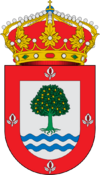Alagón del Río facts for kids
Quick facts for kids
Alagón del Río
|
|||
|---|---|---|---|
|
|||
| Country | Spain | ||
| Autonomous community | Extremadura | ||
| Province | Cáceres | ||
| Comarca | Vegas del Alagón | ||
| Area | |||
| • Total | 13,82 km2 (534 sq mi) | ||
| Population
(2018)
|
|||
| • Total | 934 | ||
| • Density | 0.6758/km2 (1.7504/sq mi) | ||
| Time zone | UTC+1 (CET) | ||
| • Summer (DST) | UTC+2 (CEST) | ||
Alagón del Río is a small town in Spain. It is located in the province of Cáceres, which is part of the Extremadura region. In 2013, about 889 people lived there. This town became independent from Galisteo in November 2009.
Contents
Discovering Alagón del Río's Past
How Alagón del Río Started
Alagón del Río was first known as Alagón del Caudillo. It was built as a new village for people who had to move. This happened because the Gabriel y Galán reservoir was being built. Their old homes in Granadilla and Martinebrón would soon be covered by water.
Over time, people from many different places also came to live here. Other new villages were built nearby, like Valrío and El Batán.
In 1955, a big plan was approved for the Gabriel y Galán area. This plan was about building the dam and helping people settle in new places. The National Colonisation Institute was in charge of making this plan happen.
Work began on important projects. These included the Gabriel y Galán reservoir and new canals. These canals would bring water to the farms. Starting in 1957, the land for the new village was prepared.
The first families arrived in April 1958. They came from Granadilla. More families arrived later that year. Some settlers also came from villages in Salamanca, like Martinebrón.
Early Challenges and Growth
When the first families arrived, they did not have proper houses. They had to live in simple warehouses called barracones. Each family was promised a house and a piece of land for farming.
The first houses were ready in 1960. But electricity did not arrive until 1964. Running water was installed even later, in 1969. In the early years, the village was quite isolated. To get to Galisteo, people had to cross the river by boat.
There were also no services in the village. Some early harvests were lost because the water canals were not finished. This made things very hard for some families. Because of money problems, some families had to leave. But slowly, things got better. The people worked hard to improve their new village.
Becoming an Independent Town
In 1979, Alagón del Río became part of the municipality of Galisteo. This meant it was managed by the local government of Galisteo. The mayor of Galisteo chose a person to represent Alagón del Río. In 1983, a special council member was chosen for the first time.
Also in 1983, the town's name was changed. It became simply Alagón. The people of Alagón wanted their town to be fully independent. In 1995, all local political groups promised to help Alagón become its own separate municipality. This goal was finally achieved in November 2009.
See also
 In Spanish: Alagón del Río para niños
In Spanish: Alagón del Río para niños



